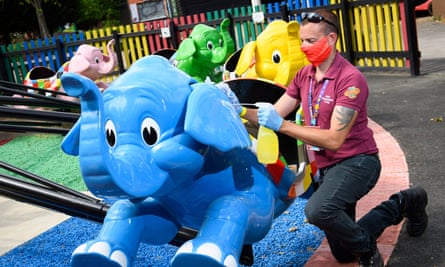The easing of multiple lockdown measures in England at once risks Covid-19 gaining a fresh foothold, scientists advising the government have warned.
They raised concerns over the halving of the 2-metre physical distancing rule at the same time as reopening venues, saying the country was currently experiencing up to 4,300 Covid-19 infections a day and had no effective digital track-and-trace system, while highlighting research that showed transmission of the virus was more likely to happen indoors.
Q&AWhat does the 'R' number of coronavirus mean?
Show
R, or the 'effective reproduction number', is a way of rating a disease’s ability to spread. It’s the average number of people on to whom one infected person will pass the virus. For an R of anything above 1, an epidemic will grow exponentially. Anything below 1 and an outbreak will fizzle out – eventually.
At the start of the coronavirus pandemic, the estimated R for coronavirus was between 2 and 3 – higher than the value for seasonal flu, but lower than for measles. That means each person would pass it on to between two and three people on average, before either recovering or dying, and each of those people would pass it on to a further two to three others, causing the total number of cases to snowball over time.
The reproduction number is not fixed, though. It depends on the biology of the virus; people's behaviour, such as social distancing; and a population’s immunity. A country may see regional variations in its R number, depending on local factors like population density and transport patterns.
Hannah Devlin Science correspondent
On Monday, it was announced that millions of people with underlying health issues would be permitted to leave their homes and mix with groups from 6 July, for the first time in three months.
On Tuesday Boris Johnson gave venues from museums to pubs to hairdressers the green light to reopen from 4 July, halved physical distancing from 2 metres to 1 metre and said two households could meet up indoors, both also from 4 July.
Acknowledging the relief many would feel – the Daily Express headline on Tuesday was “Freedom pass for millions” – Johnson called it the end of a “long national hibernation”. However, scientists made clear that it came with risk.
Prof John Edmunds, an epidemiologist at the London School of Hygiene and Tropical Medicine, who sits on the Scientific Advisory Group for Emergencies (Sage), said: “The social distancing rules that have been in place since March have had two effects: first, the number of contacts that we make has been drastically reduced; and second the nature of these contacts has also become safer, as we seldom meet inside and we have been maintaining 2 metres of distance wherever possible.
“Relaxing the 2-metre rule at the same time as opening bars and restaurants does run the risk of allowing the epidemic to start to regain a foothold. These changes will have to be very carefully monitored and the NHS track-and-trace system will have to be working properly to help keep us safe.”
Prof Susan Michie, a psychologist on a subgroup of Sage, cited research suggesting 97% of super-spreading events, with five or more transmissions, have taken place indoors.
She said that while the government was entitled to make a political decision – as Downing Street has indicated it has – it was important to be fully transparent, so the public could fully understand the risks and see whose advice it was relying on.
“The key thing is that we don’t have a [digital] test, trace, isolate system in place,” said Michie, who is also a member of Independent Sage. “And I think that’s the reason that the World Health Organization said last week that they thought the UK should not lift any more restrictions. It’s why other countries have 1 metre because they have other precautions and other systems in place that we don’t have.

She pointed to the current high transmission rate and added: “Hospitalisations are not coming down dramatically and the fact that we’ve just had opening of non-essential shops and a range of other things, I think, not the best time to reduce it [the 2-metre rule].”
Office for National Statistics (ONS) figures, published on Tuesday, showed that the latest weekly number of deaths from Covid-19 in England and Wales was 1,114, the lowest since 27 March, shortly after the imposition of the full lockdown on 23 March. On Monday, the official tally of UK deaths from Covid-19 was 15, the lowest number since 15 March.
The latest ONS infection statistics show that approximately one in 1,700 people in a community setting in England (not in a hospital, care home or similar) had Covid-19 at any given time between 31 May and 13 June. This compares with one in 400 between 3 May and 16 May.
But there have been concerns that the R value, showing the transmission rate, has been rising and is close to – or even above (different studies vary) – 1 in certain regions, which could lead to an exponential increase in cases.
Rowland Kao, professor of veterinary epidemiology and data science at the University of Edinburgh and not affiliated to Sage, said: “If the current R – bearing in mind there is a lag – is about 1, and the pre-lockdown R was around 3 to 4, then the difference, of about 2 to 3, is made up by things that we aren’t doing that we were doing before (at least so long as the number of people who are immune is relatively few).
“As we move through the gears of releasing lockdown we will ‘recover’ some of those missing events. The important thing is that we do so in a way that the change isn’t too sudden. Of course things like face masks will likely help to keep it down – but we don’t yet know how much.”
